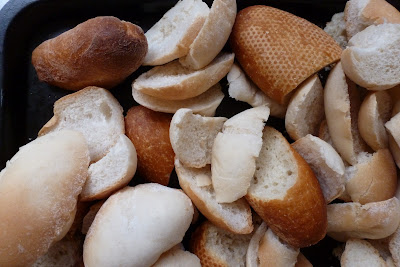The first is best made with bread that is a few days old, bread that is dry, but not brittle. If you let your bread sit for more than a week, so that it's completely hard throughout, you can make the second dumpling.
The first dumpling, made with days-old bread, is the serviettenknoedl, which literally translates as "serviette dumpling." Much like the French word torchon, which means towel, servietten implies that the dumplings are shaped into cylinders by rolling in a towel or serviette.
The old bread is first cubed and soaked in milk, butter, and egg (full recipe below).
Then the mixture is rolled into cylinders. Traditionally this was done with a towel or napkin, but plastic wrap and aluminum foil are more common these days.
The rolls are steamed or poached until the egg has set, about thirty minutes, though cooking time depends on the diameter of the dumpling. Once cooked the rolls can be chilled overnight, then sliced into rounds.
The rounds are often seared in butter for a bit of colour and crispness.
In Austria, serviettenknoedl are most often served with stews and braises. Below you can see them with Maibocgoulash (May deer goulash) and cranberries.
They are also an important ingredient in a regional dish called Tirolergroestl. Tirol is a province in Austria, and groestl simply means hash. Tirolergroestl usually includes ham or speck, potatoes, vegetables, knoedl, and a fried egg with a runny yolk.
Napkin Dumplings
serviettenknoedlIngredients
- 1 lb bread, between one and seven days old, dry but not brittle
- 4 large eggs
- 2 large egg yolks
- 4 oz unsalted butter, melted
- 1 cup whole milk
- 1 tbsp kosher salt
- Cut the bread into cubes, anywhere from 1/4" to 1".
- Mix all remaining ingredients and pour over the bread. Using your hands, gently toss the bread until all the liquid has been absorbed. Let the mixture sit for 1 hour.
- Shape the mixture into a cylinder 2-3" in diameter. Do not compress the bread, as this will yield a dense, tough, dumpling.
- Poach the rolls in gently simmering water until firm throughout, about 30 minutes.
- Remove from the water and let cool overnight.
- Slice into rounds of desired thickness.
- To serve, fry the rounds in oil and butter until golden brown and crisp.
If you find yourself with bread that is more than a week old, bread that has gone completely dry and brittle, you'll be better off making broeselknoedl, or breadcrumb dumplings. Use a food-processor to pulverize the stale bread into crumbs. The procedure is then similar to making napkin dumplings, only breadcrumb dumplings are typically shaped into balls, not cylinders.
This dumpling also traditionally accompanies stews and braises.
Breadcrumb Dumplings
broeselknoedl
Ingredients
- 1 lb bread crumbs
- 1/4 cup all-purpose flour
- 4 large eggs
- 2 tbsp unsalted butter, melted
- 1 tbsp kosher salt
- Combine the eggs and melted butter. Stir in the breadcrumbs, flour, and salt. Let the mixture stand for 30 minutes so that the dry ingredients can absorb the moisture.
- Shape into balls with a 2.5" diameter. Poach in gently simmering water until cooked through, about 8 minutes, depending on the size of the dumplings.




















